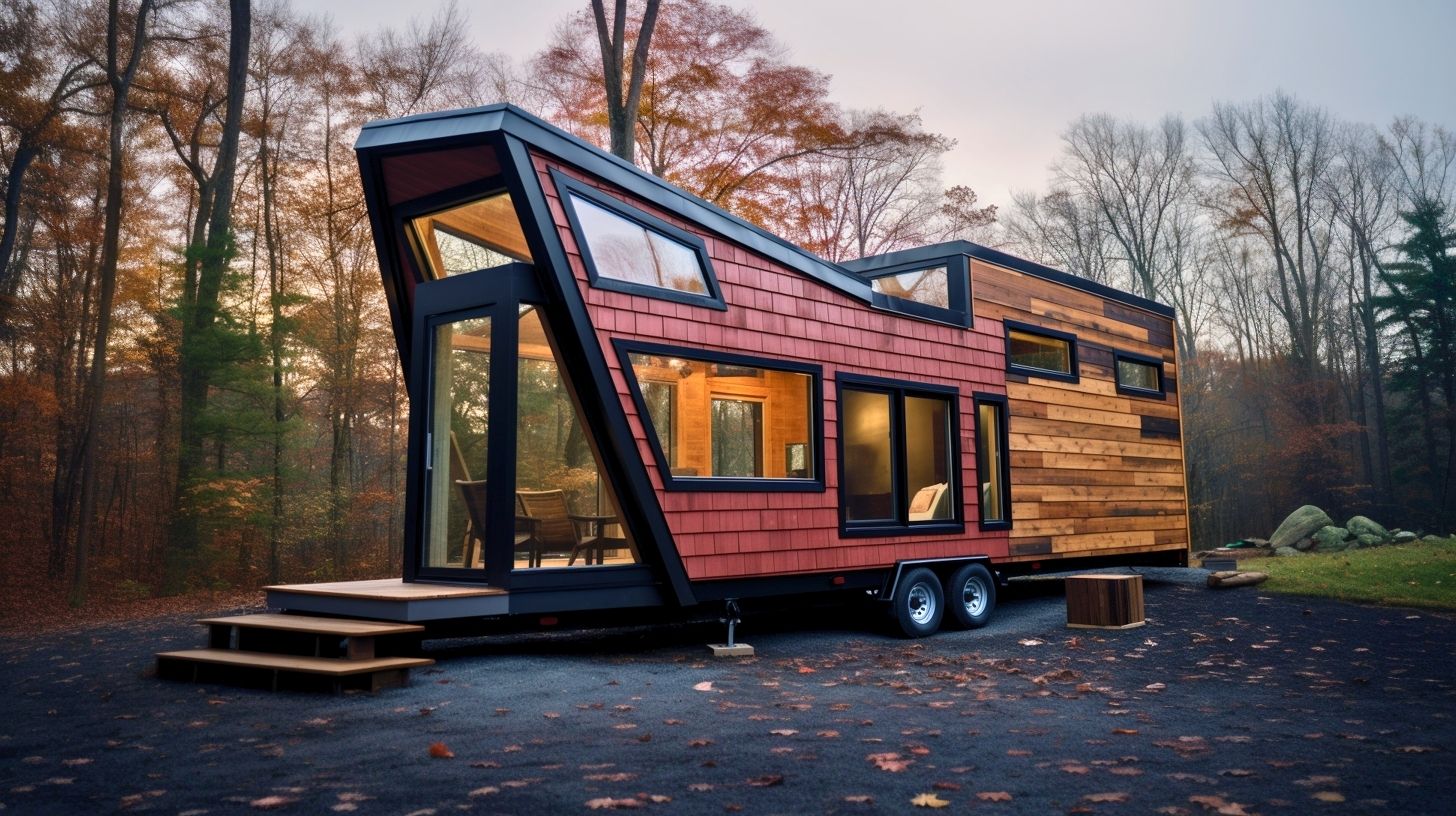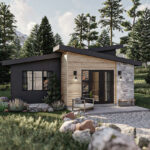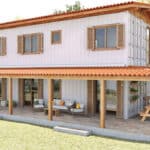There is a seismic shift happening in the world of home ownership. An increasing number of people are rejecting traditional multi-bedroom houses in favor of small, cozy, and efficient living spaces: tiny homes.
These pint-sized abodes offer a unique blend of practicality and sustainability, often appealing to free-spirited minimalists and eco-conscious individuals longing for a lifestyle overhaul.
The desire to lessen one’s environmental impact, to declutter, and to achieve financial freedom are among the many motivations fostering this shift.
This journey into understanding the allure of tiny houses, providing an in-depth view of what you need to know when navigating the tiny house market and guiding you through the intricate process of acquiring one, is the essence of this narrative.
Understanding the Tiny House Trend
The tiny house movement has its roots in the late 1980s and early 1990s when owners wanted to downsize to a more affordable and sustainable living.
This trend gained momentum during the 2008 financial crisis as people sought to simplify their lives and make housing more affordable.
The idea of a tiny house is centered around living a minimalist, less consumption-oriented lifestyle that offers freedom both financially and in terms of mobility.
Tiny houses are generally smaller than 500 square feet and come in various shapes and sizes, ranging from self-built structures on wheels to professionally designed and constructed models. They are often customized to the owner’s specific needs and preferences.
Who might be interested in a tiny house?
The tiny house trend has become popular among multiple demographics. For some, it is a way to escape the cycle of long-term mortgages and focus on experiences over possessions.
Tiny houses also appeal to those passionate about preserving the environment, as these smaller homes typically consume fewer resources and produce less waste than traditional houses.
Innovation in design and utility has expanded the appeal of tiny houses, making them an attractive option for a wider variety of homeowners.
They are attractive to retires looking to downsize, young professionals drawn to minimalist living and even families who enjoy the challenge of living small and sustainably.
Benefits of Owning a Tiny House
The benefits of owning a tiny house are multifaceted. Financially, the initial cost of purchasing or building a tiny house is typically much less than that of a traditional home.
Additionally, monthly expenses such as utilities, maintenance, and taxes are significantly reduced due to the smaller footprint.
For environmental enthusiasts, tiny homes offer an ecological advantage. These small dwellings require less energy to heat and cool, less water to maintain, and are often made from sustainable, recycled materials.
They also generally come with compost toilets and small solar panels, reducing the reliance on fossil fuels.
Beyond the hard-cost savings and environmental benefits, many tiny house owners cite the psychological advantages of their choice.
Simple living can reduce stress and promote a sense of peace, leading to improved mental health. It also contributes to a sense of community and connection with nature.
Understanding the Realities of Tiny House Ownership
While owning a tiny house brings with it several benefits, it also presents a set of unique challenges.
Many tiny house owners, particularly those living in mobile homes, encounter legal restrictions primarily due to zoning laws.
These laws, present in numerous locations, prevent the establishment of small-sized structures as permanent homes.
Consequently, it’s not uncommon for some tiny house owners to transition into a semi-nomadic lifestyle, rotating their residence between RV parks or rural areas with more flexible legislation.
Additionally, the significant reduction in living space necessitates a drastic lifestyle change and a downsizing of possessions.
Yet, it’s important to recognize that for many tiny house owners, these challenges are outweighed by the advantages.
The Tiny House Movement emphasizes how perceptions of “home” can vary and how decreased space doesn’t necessarily equate to reduced quality of life.
Finding the Perfect Tiny House for Sale
Broad Variety of Tiny Houses Available for Purchase
The market for tiny houses is diverse, offering a plethora of styles to cater to any taste. Whether you’re drawn to rustic cabins, modern mini-houses, homes built from shipping containers, or even converted vans, there’s a tiny house out there to match your preferences.
You can opt for a mobile tiny home if you have a love for travel, or choose a fixed tiny house if you prefer a more permanent living situation.
Regardless of the style, these homes typically range in size from less than 100 up to 400 square feet.
Layouts and Features of Tiny Houses
Regardless of exterior style, the interior layout of a tiny house is crucial to ensuring it can meet the user’s needs.
Some tiny homes focus on providing ample storage, including hidden compartments beneath floors or seating areas. Others prioritize spacious living or kitchen areas, for those who value socializing or cooking.
Notable features often include multi-purpose furniture, loft sleeping areas, and compact appliances. It is important that potential buyers carefully consider their needs and lifestyle when choosing a tiny house layout.
Where to Find Tiny Houses for Sale
Tiny houses can often be found on various online platforms. Websites dedicated to tiny living often feature listings, as do general real estate websites.
Additionally, social media groups focused on tiny living can be excellent resources. Offline, home and garden shows, as well as tiny house expos, offer the opportunity to view a variety of styles and layouts firsthand.
Evaluating a Potential Tiny House Purchase
Potential buyers should look for quality construction, including good insulation and durable materials. If considering a pre-owned tiny house, it is important to check for signs of damage or wear.
Potential issues may include water damage, plumbing or electrical issues, or structural problems. Prospective buyers may wish to enlist the services of a qualified home inspector.
Budgeting for a Tiny House
In addition to considering the purchase price of a tiny house, potential buyers need to budget for ongoing costs. These may include maintenance and repairs, insurance, and utilities.
If the tiny house is mobile, owners should also factor in potential travel costs. Financing for tiny houses is different from traditional homes, as many lenders do not offer loans for these unique structures.
As such, potential buyers often turn to personal loans or RV loans to finance their tiny homes.
Understanding the Tiny House Lifestyle
Before plunging into the tiny house market, it’s crucial to ascertain if this alternative residential option suits your lifestyle.
Residing in a small space demands a certain degree of minimalism and exemplary organizational skills. Keep in mind, the charm of tiny house living, often delivers a stark contrast from the conveniences of a traditionally-sized home.
Yet, the lure of a clutter-free space, minimalistic lifestyle, and potential low costs make the transition appealing to many.
The Process of Buying a Tiny House
Financial Planning for Your Tiny House
Moving into the next stage of your tiny house adventure involves securing the all-important financing.
Traditional mortgages are not always accessible for acquiring tiny houses, particularly those that are mobile. Thus, investigating other financial avenues like personal loans, RV loans, or even crowd-funding becomes essential.
Take the time to explore various options that offer the most favorable rates and conditions suitable for your circumstances. Be ready to demonstrate your repayment capacity to secure the loan — as most lenders will require it.
Checking Local Zoning Laws
Before signing the deed, it’s critical for buyers to understand local zoning laws. Some areas may have specific regulations related to tiny homes and their placement, typically tied to the size of the home and what constitutes a legal dwelling.
Some areas do not allow tiny houses at all, while others may only permit them in certain zones or as accessory dwelling units (ADUs) on properties with larger traditional homes. You might also need specific permits and inspections depending on your area.
Plan your tiny home dream with a clear understanding of what’s legal in your local jurisdiction.
Understanding Tiny House Certifications
Tiny house certifications play an important role in guaranteeing safety standards and building practices. Several organizations, like the National Organization for Alternative Housing (NOAH) and the Recreational Vehicle Industry Association (RVIA), offer certification programs within the tiny house industry.
These certifications ensure that your tiny house is built to meet specific safety and construction standards. A certified tiny house may not only give you peace of mind; it might also be a requirement in some areas or for certain types of financing.
The Role of Real Estate Agents and other Professionals
Though certainly not necessary, working with real estate agents or consultants who deal specifically with tiny homes can streamline the process. These professionals can help navigate the complexities of local laws and financing, and their experience could save you time, money, and stress.
They can also be invaluable in negotiations, ensuring you get a fair deal and protecting your interests during the contract stage.
Negotiating Prices and Contracts
As with any home purchase, negotiating prices and contracts is a key stage in buying a tiny house. Be sure to thoroughly inspect the house or plans before making an offer.
You should also know the current market to ensure you’re getting a good deal. Don’t be afraid to negotiate; sellers expect it.
Consider hiring a lawyer to review the contract before signing it. Remember, in most cases, you’ll be the one moving into and living in the tiny house – making certain it’s exactly what you want (at a price you can afford) is worth the effort and diligence.
Navigating the waters of tiny house ownership can be a thrilling yet overwhelming adventure.
It requires careful planning, diligent research, an understanding of legal requirements, and an evaluation of the nitty-gritty of the tiny house lifestyle.
Nonetheless, the reward can be life-changing—a step towards a simpler, more sustainable, deliberately designed lifestyle that aligns with modern priorities like environmental conservation and financial freedom.
As the narrative unravels, hopefully, it offers an empowering map to guide potential tiny homeowners, facilitating informed decisions and aiding every step of this captivating journey towards tiny house ownership.













